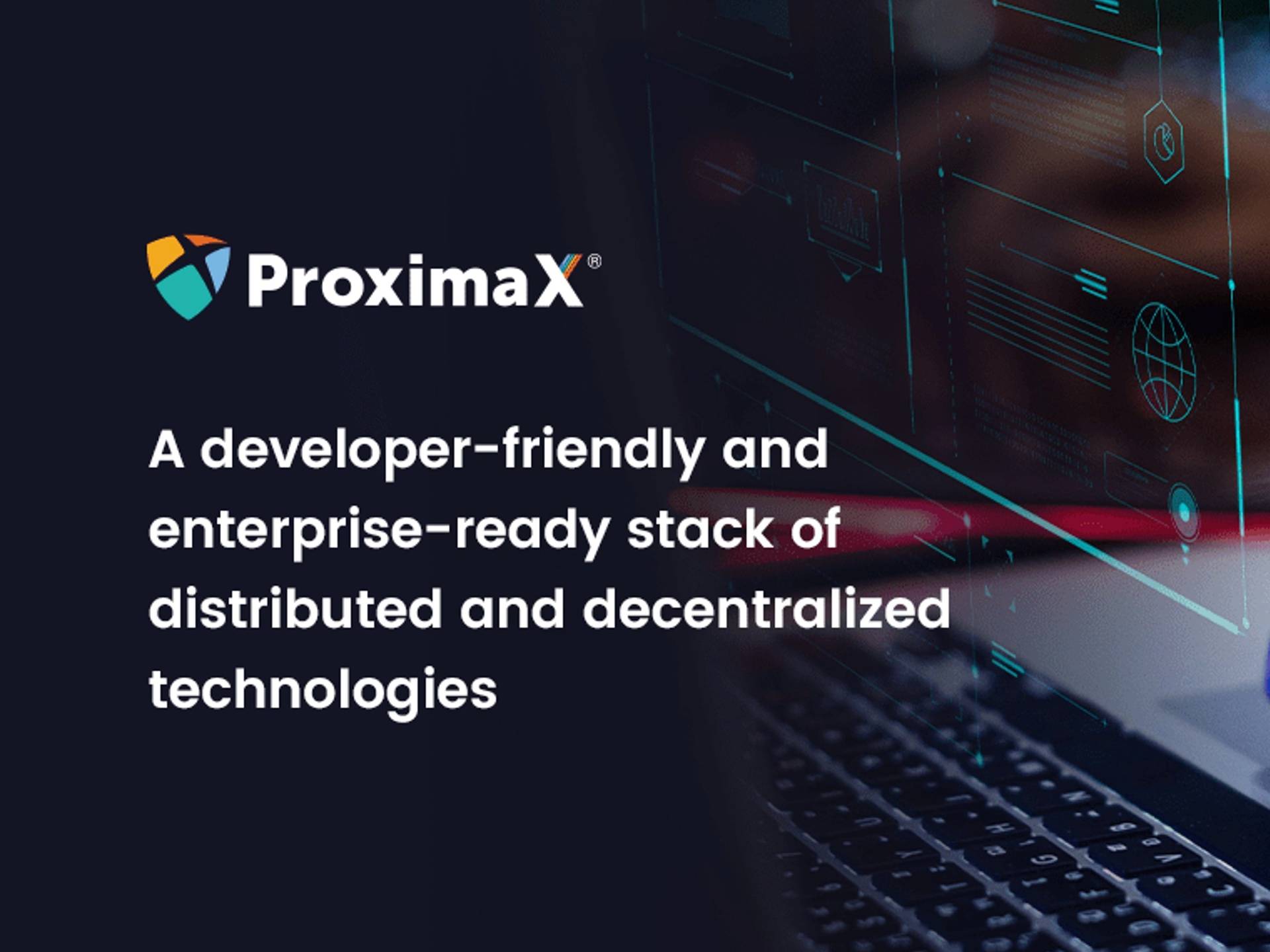订阅 wiki
Share wiki
Bookmark
ProximaX
ProximaX
ProximaX 是一个由区块链技术驱动的下一代集成和分布式账本技术(“IaDLT”)开发平台。它利用 NEM 区块链技术来提供私有和公共区块链解决方案。它还可以作为去中心化存储和内容分发网络,提供基于星际文件系统 (IPFS) 和分布式文件管理系统 (DFMS) 协议的存储解决方案。XPX 代币是一种原生代币,用于订阅 ProximaX 网络上应用程序服务提供商提供的服务。[1]
概述
ProximaX 概述 ProximaX 是一个由 Lon Wong 和 Alvin Reyes 创立的区块链项目。该项目旨在建立一个可持续且快速的网络协议,以改进现代区块链结构。该项目的主要重点是为去中心化应用程序 (dapp) 开发者提供一系列便捷的服务。该项目由其自身的 ProximaX 代币 (XPX) 提供支持。通过具有标准化框架的区块链协议,可以插入更多的核心服务,以利用平台的可扩展基础设施。[2]
它是一个企业级的基础设施和开发平台,集成了分布式账本和区块链技术与分布式和去中心化服务层,如存储、流媒体、数据库和超级合约。它旨在提供公共和私有区块链服务和存储解决方案,这些解决方案将是去中心化的,并基于 P2P 网络。它是一个一体化、易于使用的平台,可以扩展更多的服务层,而不会影响性能。ProximaX 平台可在私有、公共和混合网络配置中使用。[3]
它由多个核心服务支持,如流媒体、存储和超级合约;通过通用的区块链协议连接在一起,用于识别、激励、消息记录、状态管理和资产交换。[2]
ProximaX 旨在为 DApp 开发者提供一个直观易懂的 SDK,使用户能够将抽象的 ProximaX 协议层建立在 NEM 区块链层之上,以提供各种 dApp 协议的维护。[1]
为了实现这些目标,ProxmiaX 开发了两个主要平台,Sirius Blockchain 和 Sirius Storage。Sirius Chain 提供先进的企业区块链,具有内置功能,如多层多重签名、拉取交易、聚合交易和跨链能力,以支持高级解决方案。Sirius Storage 是一个分布式文件共享系统,企业可以在世界各地无缝地存储和共享文件。智能合约平台 - Supercontract 和流媒体网络 - Sirius Stream 尚未推出。[3]
ProximaX 平台将其描述为去中心化服务中的范式转变,是原始开放去中心化系统自然演变的结果。ProximaX Sirius 的一个显著特点是其不断扩展的多元节点参与者生态系统,每个节点都通过一组软件开发工具包(“SDK”)和 HTTP/S 端点,以可访问的应用程序编程接口(“API”)的形式提供其独特的服务。[1]
ProximaX 于 2018 年在 NEM 的 NS1 区块链上推出,并于 2019 年 9 月 25 日,该团队推出了主网。[3]
Sirius 区块链
Sirius 链是 ProximaX 的区块链,用于记录核心服务生态系统中发生的所有操作、事件和交易。它是 NEM 区块链的一个分支,经过开发使其得到改进并兼容,从而更好地适应扩展的核心服务需求和放置在网络上的侧链。[2]
它使用权益证明 (PoS) 共识算法,该算法将财富和年龄作为节点信誉系统的一部分,从而决定节点验证交易的机会。它是一个智能合约就绪的区块链,可以创建用于不同商业目的的合约。例如,可以创建数字代币来代表现实世界的资产,各种服务也可以被代币化。[1]
Sirus 区块链还包含一个扩展的信誉输入,称为“贪婪证明”,它可以确保在考虑区块生成时间的同时,没有节点在接受具有高额费用的交易时变得过于“贪婪”。这使得 tor 形成一个更公平的网络,责任和激励措施分布在所有区块链节点上。[3]
XPX 是 Sirius 区块链的原生代币,所有使用该平台核心服务的消费者都将使用它,并激励节点参与者。消费者将支付 XPX 来使用公共平台。节点验证者将收到 XPX 作为验证交易和添加新区块的费用。每个区块都包含附加费用的交易。这些费用加在一起形成一个“区块奖励”,然后将其分配给参与该过程的不同验证者。用户可以使用 Sirius 钱包作为消费者参与。[1]
验证者
区块链验证者 如前所述,Sirius链运行在权益证明机制上。要作为验证者节点参与,用户需要质押XPX代币。质押的金额随后通过验证者软件与参与者的账户绑定。[3]
要运行一个节点,参与者需要了解潜在的奖励和风险。参与者需要下载节点并安装软件,并生成一个账户或导入一个现有账户。然后,节点软件将使用账户的历史、年龄和财富执行验证过程,以确定节点的信誉。一旦验证者节点运行,它将尝试获得验证工作。如果验证者节点被PoS共识算法批准并选择用于工作,那么它将为区块生成过程做出贡献,并将从区块奖励中获得分成。获得的奖励将转移到节点的账户。[2]
根据ProximaX的模拟实验,最低和推荐的质押金额为:
| 最低质押金额 | 250,000 XPX |
|---|---|
| 推荐质押金额 | 2,500,000 XPX |
。
核心功能
Sirius Chain 具有以下内置核心功能
账户
与其他区块链类似,Sirius链上的账户与密钥对(私钥和公钥)相关联。它与存储在Sirius链上的可变状态相关联。换句话说,用户将在区块链中拥有一个“储物箱”,只有他/她可以使用其密钥对进行修改。私钥必须保密,任何有权访问私钥的人最终都可以控制该帐户。
命名空间
命名空间允许用户在Sirius Chain上为其业务和资产创建一个链上唯一的位置。它从用户选择的名称开始,类似于互联网域名。如果一个账户创建了一个命名空间,它将在Sirius Chain生态系统中显示为唯一的。用户可以通过声明别名交易将名称与账户地址或“马赛克标识符”相关联。绑定命名空间和资产的地址被称为“长账户地址”和可识别的“马赛克标识符”。
马赛克
马赛克使平台独特而灵活。它们代表了Sirius Chain上的固定资产,可以由一组多个相同的、不变的资产组成。马赛克可以是代币,也可以是更专业的资产集合,如奖励积分、股份、债券、认股权证、签名、状态标志、投票,甚至其他货币。这些马赛克还可以具有独特的属性:可分性;持续时间;初始供应量;供应量可变性;可转移性。这些属性可用于建立限制和控制。它们可以代表同质化和非同质化资产。
例如,可以改变供应量来控制价格通胀;可以限制可转移性来控制马赛克的使用方式。如果马赛克代表一类相似的资产,例如XPX代币(实际上是一种马赛克),那么它是同质化的。反之亦然:如果它代表一种独特的资产,那么它就不是同质化的。一个例子是一块独特的土地。一块与另一块土地大小完全相同的土地不是同质化的,因为它是独一无二的。[1]
元数据
元数据是一种在Sirius Chain中存储自定义数据的方法。默认情况下,账户、命名空间和马赛克等数据都是不可变的,因此限制了存储需要与这些状态对象相关联的额外数据的灵活性。元数据通过创建数据附件到Sirius Chain上预定义的对象来解决这个问题,从而创建了存储额外数据的灵活性。它可以随时添加、更新和删除。一个账户可以向其地址、命名空间和它拥有的马赛克添加元数据。
多级多重签名
多级多重签名用于在链上创建多级协议。多重签名是多个拥有特定账户(通常称为子账户)托管人的参与方之间达成的协议。Sirius Chain 扩展了此功能,可以创建多个级别的协议,使其更适用于需要工作流程或全面审批流程的系统。[2]
跨链和聚合交易
Sirius链允许在两个Sirius链之间进行跨链交易,无论是私有链还是公有链。这是一种在不同链上的两个参与者之间交换资产的有用机制。Sirius平台中的跨链使用锁定资金的概念,即资金在跨链时被锁定,然后在反向时被解锁。这类似于原子互换,涉及在一条链上锁定资金,然后在另一条链上发行此类资产。跨链交易有助于开启许多用例。例如,如果私有区块链需要使用主网公有链的XPX来支持其内部经济,它可以从主网链发送XPX来为私有链提供动力。私有链可能需要在主网平台中存储其数据。这可以通过将XPX从私有链发送到主网公有链来完成。[3]
Sirius链旨在处理聚合交易,其中它将多个交易合并为一个批次交易,从而允许无需信任的交换和其他高级逻辑。Sirius链通过生成一次性合约来实现这一点。当所有相关账户都共同签署了聚合交易时,所有内部交易将同时执行。[1]
自动化内部交易所
它是一个构建在天狼星链之上的二层解决方案,旨在促进平台原生代币 (XPX) 和服务单元之间的交换。它使多个内部代币的交换成为一个简单而实用的过程,以便用户可以轻松使用平台的核心服务。开发人员可以使用 ProximaX Sirius 的可扩展基础设施创建自己的核心服务和相应的代币经济,并且自动化内部交易所可用于交换新型服务单元。[2]
Sirius 存储
dApp 和系统解决方案需要存储容量,对于任何区块链来说,在其核心服务中包含存储至关重要。Sirius 存储是一个去中心化的存储平台,能够存储所有类型的二进制数据,无论是图形、视频还是文本。它可以为任意性质的文件提供可靠的存储。可靠性级别由存储驱动器的用户决定,并且与支付的费用密切相关。与类似的中心化云服务相比,它具有超越中心化模型进行扩展的优势,并且由于没有中间商以及存在开放的存储服务市场,因此可以保持价格竞争力。
dApp 可以发出存储请求,这些请求以交易的形式记录在 Sirius 链上。在这个过程中,有三个参与者扮演着重要的角色。网络贡献者可以选择成为以下节点参与者中的任何一个、两个或全部。
这些参与者是 -
- Acceptor:这些节点为 Replicator 提供文件传播,并为最终消费者提供文件交付。
- Replicator:这些节点复制文件并存储复制的内容。
- Storage Verifier:这些节点识别不再存储所需文件或已离线的 Replicator,如果识别到,则启动这些文件的进一步复制。
Acceptor 是 Replicator 的文件传播者,然后 Replicator 存储这些文件。Acceptor 收取带宽费用 (SM) 以传输文件数据,而 Replicator 收取存储空间 (SO) 和带宽的费用。当这些存储请求被 Acceptor 节点接受并由 Replicator 节点满足时,存储服务将被激活。[1]
存储经济
原生代币 (XPX) 由消费者用于支付分布式存储服务费用。费用基于存储的市场价值,并由自由市场经济模型决定。自动内部交易所负责将 XPX 转换为服务单元,最终支付给节点。
代币经济框架由存储单元 (SO)(存储文件所需)和流媒体单元 (SM)(在节点之间流式传输文件数据所需)组成。这些服务单元代表存储生态系统中的货币资产和容量,用于执行以下交易
- 消费者支付服务费。
- 激励节点运行服务。
- 代表节点提供服务的能力。
在外部/不同链上创建的代币旨在用于其自身的生态系统中。但是,由于所有链都具有通用的集成点,因此可以使用自定义服务或 RestFul API 在它们之间构建通用的支付网关。外部支付方式还可以包括法定货币作为传统手段。然后,消费者可以将外部代币转换为 XPX,然后可以使用 XPX 支付 Sirius 存储服务费用。[2]
节点运营商
Sirius Storage旨在处理消费者依赖的关键数据,多个存储节点是该网络的主干。要在网络中运行节点,需要对网络有一定程度的理解和承诺。要参与,节点所有者必须证明其容量和能力。节点所有者需要获得服务单元,然后通过存储证明来验证参与节点是否确实能够提供服务。验证后,存储节点将连接到网络,并会被其他对等方自动发现。节点的容量与节点持有的服务单元数量有关。[3]
存储合约
存储合约是存储服务条款的数字要约和承诺。违反合约条款会受到惩罚。如果存储验证器发现复制器节点未提供约定的服务,则复制器的股份(根据合约存入)将被没收,并且复制器将失去声誉。没收的股份将被发送到接收帐户。
存储合约流程如下:
- 消费者支付 XPX 以获得特定数量的存储空间。
- 受让人知道存储请求。然后,受让人以 SM 单位支付报酬,这些单位通过自动内部交易所从 XPX 转换而来。
- 同意参与合约的复制器使用自分配和发现机制。这些复制器竞争存入他们的 SO 和 SM 单位,表明他们跨不同复制器存储和流式传输的能力。
- 然后是合约的执行,所有各方都同意参与。这一切都是通过协议级别的自动化流程完成的。
启动合约时,必须设置持续时间。分布式存储能力只能租用而不能拥有,因此需要基于订阅的模式来满足存储请求。要持续使用存储容量,消费者需要根据合约定期支付 XPX 租金。
共识机制
每个存储节点都会受到存储验证者的挑战,复制者可以通过证明其拥有复制数据来解决该挑战。对于此验证,Sirius Storage 使用两种预定义的存储证明变体
增强型存储证明
它是所使用的两种算法中最突出的验证过程。在此过程中,当上传文件时,会进行一个称为“分片”的过程,将文件分成块。然后将这些块分散在复制器上,并使用复制器的共享密钥进行加密。然后,密钥允许网络在复制器之间启动验证过程。每个复制器将带有加密相关元数据的文件块发送给其他复制器。如果文件及其元数据之间存在不匹配,复制器将通过多重签名交易达成一致,以进一步复制文件并删除有故障的复制器。[1]
简化存储证明
增强型变体可能需要时间来处理,因此复制者也可以使用简化存储证明来快速验证其拥有的文件块的存在性。验证过程基于简单的 ping 实用程序,使用根文件的签名作为 ping 的基础。复制者将有效地检查其他复制者是否具有相同的根文件签名,而不是验证属于该文件的每个块的签名。
核心功能
节点运营商执行以下功能以执行存储过程。
存储准备
存储准备是一项核心功能,主要简化了分布式存储服务的准备过程。当消费者请求存储时,驱动器准备过程开始。消费者需要支付XPX,这些XPX将通过自动内部交易所转换为服务单元(SO)。然后,邀请接受者和复制者同意存储合同。合同条件包括价格、存储大小和持续时间。为了同意合同条件并展示提供服务的能力,接受者质押SM单元,复制者质押SM和SO单元。一旦达成协议,合同将在天狼星链上宣布并确认。然后,存储驱动器准备好接受数据文件。[2]
复制器
复制器加入示意图 复制器可以由希望提高服务可靠性或增加存储容量的消费者触发。它们被配置为主动搜索新的存储合约以参与。加入需要满足几个条件,包括实际存储容量、位置和声誉。一旦复制器具备能力,协议会自动将所选复制器的公钥包含到合约中,该合约将成为文件块持有者之间交叉验证检查的一部分。[3]
上传
要上传文件,存储驱动器应具有相应的功能。上传过程始于消费者上传文件,然后Acceptor“暂存”文件,之后文件将被流式传输到Replicator。Replicator将相同的文件流式传输到其他Replicator,然后由存储验证器进行验证。在此过程中,Replicator充当存储验证器,它们相互验证容量并确保服务得到适当提供。
删除
“删除”功能允许使用者请求合约中的复制器集发出“删除”命令。作为合约一部分的复制器将在各自的环境中执行该命令。[3]
修改
“修改”命令允许使用者请求更改存储驱动器中的特定目录或文件。它本质上调用两个步骤:“删除”和“上传”。第一步或“删除”命令向复制器发出指令,确保文件从它们各自的环境中删除。这也会删除存储和区块链级别上对旧文件的任何引用痕迹。第二步或上传命令将上传一个新文件来替换第一步中删除的旧文件。[2]
重命名
它允许使用者重命名存储驱动器中的特定目录或文件。鉴于名称不是内容寻址存储识别机制的一部分,因此不会有任何文件内容流来传播更改,因为修改仅在分布式哈希表(“DHT”)级别完成。[1]
目录
它是一个命令,用于返回存储驱动器中的目录和文件列表。复制器使用它来评估是否需要加入合约作为复制器以扩展存储容量。这可以由消费者或想要加入存储网络的复制器发起。在消费者执行此命令的情况下,结果将存储在 DHT 中,文件结构树位于其中。如果一个新节点想要加入存储合约,它会向复制器请求文件结构树。[3]
同步
这是一个底层请求,用于启动参与存储合约的复制器之间的同步过程。每当存储驱动器发生更改时(通过常见的操作,如上传、删除等),此命令将列出合约中的所有复制器,并通过gossip协议向每个复制器发送消息。该消息将包含获取最新DHT副本的请求,该副本可能因存储驱动器中的更改而被修改,并将它们同步到它们自己的复制。
Sirius Supercontracts
Supercontract 非常简单,是智能合约的增强版本。在传统的区块链网络中,部署在区块链上的数字合约是不可变的,不允许修改合约的地址和代码。错误也很难修复。此外,链上合约会占用大量空间,导致网络膨胀和速度减慢。Supercontract 将通过将代码存储在 Sirius Storage 中来解决这个问题。这样,在获得预先建立的授权方的共识后,可以轻松地执行、停止或修改代码。Supercontract 仍在开发过程中。
Sirius 流媒体
Sirius 流媒体平台有两种形式:存储流媒体和直播流媒体。在存储流媒体中,数据会被预先录制或存储在 Sirius 存储中,然后流式传输给不同的观看者;在直播流媒体中,数据会被实时录制、传输并立即分发给观看者。这两种形式目前都尚未向用户开放。
存储流
它与存储服务连接,因为 Sirius Storage 提供数据加载。不仅流数据的拥有者可以下载,最终消费者也可以下载。这将有助于为不同领域和服务策略创建具有内容分发功能的各种应用程序。存储流使用“公平流协议”,该协议支持在彼此不认识但通过通用加密签名数据相互信任的节点之间进行流式传输。
直播
直播平台将帮助以自主且经济公平的方式,将来自单个发送源的实时数据传播到多个分发点,最终到达一个或多个接收者。
ProximaX 流媒体 API 将允许开发者创建匿名和公开的 1 对 1 和 1 对多的数据、音频和视频流。奖励将根据奖励政策的要求发放给符合条件的节点,并根据要求传输数据。节点用户可以通过允许带宽进行直播、路由存在、通信消息以及验证直播供应和消费报告来参与直播。
直播协议
它是生态系统内用于点对点直播的方法。在直播会话期间,会避免通过区块链进行奖励交易,因为这可能会导致不可预测的延迟,从而损害直播性能。相反,该解决方案使用“时间标签”来确定基于节点带宽的信誉。
带宽证明
ProximaX的流媒体平台利用带宽证明共识机制,因此节点需要通过不确定性过程提供带宽统计数据,该过程返回一组数据(时间标签),这些数据将用于确定其带宽的信誉。收集的统计数据将作为信誉评分的一部分进行加权,最终会影响每个节点被选择为用户或消费者提供服务的概率。
Sirius 钱包和浏览器
ProximaX 网络钱包和交换演示 Sirius 钱包仍处于测试阶段,有网页版以及安卓和 iOS 移动平台版本。XPX 代币最初在 NIS 1 区块链上推出,持有这些代币的用户需要将其与 Sirius 区块链上的 XPX 进行交换。所有钱包版本都提供交换功能。
XPX 代币将继续存在于 NEM 的 NIS1 区块链上,直到 2025 年或 NIS1 被弃用为止,以较早者为准。用户应尽快进行 XPX 交换,因为 ProximaX 不控制 NIS 1 区块链的开发。
Sirius 链自其主链事件以来拥有自己的浏览器,显示所有必要的信息,包括区块高度、验证器、交易和带有时间戳的费用。用户还可以选择所需的节点或手动添加节点。
ProximaX 企业
ProxmiaX 还为企业和商家提供各种解决方案。 其中著名的解决方案包括 -
mWallet
它利用先进的区块链协议和分布式账本技术来保护个人信息、支付和转账。它是一种高成本效益和可扩展的解决方案,因为它具有内置的数据管理工具和安全功能。
eDLX
增强型交易所分布式账本(Enhanced Distributed Ledger for Exchanges),简称eDLX,是一个数字证券管理平台。它具有以下特点:
- 符合监管要求且不受司法管辖限制,
- 支持一级和二级市场中的多资产和多币种交易,
- 适用于广泛的金融工具:证券、债券、衍生品和债务工具,可用于多种发行人行为,如上市、红股发行、拆股和反向拆股
- 显示实时资产持有变动以及资产持有人的完整视图
- 高效——即时和自动化的清算和结算,内置支付和KYC注册系统
- 默认情况下,所有记录都是不可变的且带有时间戳,从而可以轻松识别交易违规行为和违规事件
- API支持与其他系统(如交易所)轻松集成
- 使用超级合约来管理每个司法管辖区的合规性要求
Sirius ID
Sirius ID 演示 这是一种简单但新颖的数字身份实现方式,可以安全、可靠且尊重隐私地共享数据。它是一种自主持身份,意味着用户可以控制自己的凭据,并根据自己的意愿使用它们,而无需依赖任何中介。SiriusID系统允许用户使用Proxmax的即插即用堆栈或使用易于定制的SiriusID应用程序轻松构建自己的数字身份解决方案。
Sirius KYC
它是一种自主主权的KYC,它实现了以人为中心的数字身份和KYC数据控制。它构建于SiriusID之上。SiriusKYC应用程序通过实时和零知识证明KYC验证改进了KYC工作流程。在Sirius KYC中,个人和组织可以拥有和控制其在线数字身份和KYC数据,从而为KYC合规性创建新的范例。[2]
nCore
它被称为新银行核心系统,是数字化银行服务的框架和协议。它提供了一个区块链驱动的核心银行基础设施,内置功能使启动新银行变得廉价且容易。使用nCore,客户现在可以在短短几个月内启动他们的金融科技公司。nCore可通过各种SDK和API访问,从而可以与外部产品(如机器人咨询和智能贷款)快速集成,然后您可以快速将其推向市场。[3]
合作伙伴关系
ProximaX的企业已与多家跨国和本地公司建立了合作关系,包括华为、Logyca、新兴技术实验室、Xenber、Quillhash Technologies、LatConnect60等。[2]
Tokenomics
ProximaX 代币的交易代码为 XPX。 如前所述,XPX 最初在 NIS1 区块链上推出,但现在可以在其区块链 Sirius Chain 上与 XPX 进行交换。 总供应量为 9,000,000,000 XPX。 它在 2019 年 5 月 15 日创下了 0.007203 美元的历史新高,在 2020 年 3 月 13 日创下了 0.0003803 美元的历史新低。 它可以在 Probit、Bilaxy (交易所)、MXC 和 Kryptono 加密货币交易所进行交易。
筹款
ProximaX团队通过首次代币发行(ICO)筹集了超过3000万美元,ICO于2018年4月15日至4月30日举行。总共有50亿ProximaX(XPX)代币可供出售,价格为1 XPX = 0.009430美元。接受NEM(XEM)、以太坊(ETH)、比特币(BTC)和XAR付款。代币以股份形式出售,每股成本为750美元,不包括交易费、转换成本或其他成本。最低投资额为0.1股,相当于75美元。
公司
ProximaX由Proximax ltd.开发。它成立于2018年,并在直布罗陀注册,但主要办事处位于吉隆坡的白沙罗。该公司在新加坡也设有办事处。Lon Wong是该公司的创始人和首席执行官,Alvin Reyes担任首席技术官。该团队目前约有11-50名成员在不同地点工作。[1]
团队
Lon Wong - 创始人兼首席执行官
Alvin Reyes - 首席技术官
Sebastian Pedavoli - 联合创始人兼首席执行官
Eleazar Garrido - 主管,ProximaX Latam
Shin Neng Wong - 网络基础设施主管
Joe Chai - 亚洲业务发展主管
Patrick Hamers - 欧洲业务发展主管
Nicholas Watson - 产品管理主管
Sue Ng - 市场与传播主管
发现错误了吗?
